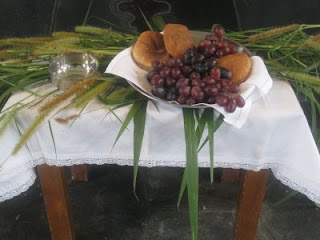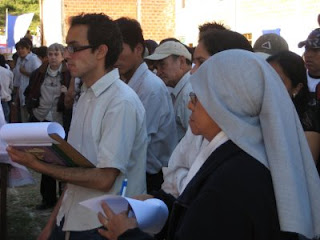I spent part of yesterday and today at the home of UAC-CP students Veronica and Zulma Calles. Veronica, a thesis student (
click here to read about Veronica) and her sister Zulma, a first-year Agronomy student, are from the small community of Santana--a 40-minute walk from Coroico.

Veronica poses in front of the one-room Little-House-on-the-Prairie-style school house in the nearby village of Mira Flores where three grades are in one classroom.
Though Veronica and Zulma are the youngest of six children, their nine-year-old nephew Nando has lived at their home for the past eight years. They consider him their little brother more than their nephew, and they treat him like their son. I was immediately struck by the fifth-grader's personality--an animated and curious little sort, he was the perfect blend of calmness and energy. Thanks to my digital camera, we were friends from the start.
Their father, Don Francisco, is a farmer who primarily grows coffee and citrus on the family's near-17 acre farm. Their mother died very suddenly of a brain hemorrhage four years ago--a tragic loss, her absence is obviously still felt each day.
Last night when Don Francisco returned home from a three-hour-long meeting at Nando's school, he and I talked while the others busied themselves with homework. Don Francisco told me about his life--his parents, his time in the military during the reign of Hugo Banzer, and his work in Caranavi. He told me about how he met his wife, recounted the births of their children, and explained how the family came to live in the home where they now reside (a landslide destroyed their previous home). He told me about Nando--how he came to live with the family and how Don Francisco is grateful for his companionship.

Zulma, a first-year student at the UAC-CP, prepares a spicy sauce for Sunday's lunch.
We also talked about education. He has a third-grade education, he said. "Back then people thought that if a man could sign his name, that was good enough. And women? They didn't need to know anything." Today, he admitted, Nando has surpassed his reading level which means Don Francisco feels a bit helpless when the fifth-grader has homework questions.
When I commended him for placing such a high value on education (particularly realizing the importance of higher education for his daughters), he responded by giving thanks to people like Hugh Smeltekop who have made steadfast commitments and personal sacrifices to help young people from the rural area obtain their undergraduate degree. "The College," he said, referring to the UAC-CP, "is a blessing for people like us because studying in La Paz would be impossible."
It was at the end of our lengthy conversation about education when Don Francisco spoke of the evening and morning prior to his wife's death. He carefully recalled what happened. Despite the years that have passed, it's obvious that it all still seems like yesterday in his mind. Today, he can't help but wonder if they could have done something differently, if they could have saved her. When he finished talking about the feelings that have ensued since her death, we sat in silence. I didn't know how to respond; I was both surprised and touched that this man trusted me with something so personal to him.
 Don Francisco prepares for work this morning. "You have a beautiful family," I told him. "You must be very proud."
Don Francisco prepares for work this morning. "You have a beautiful family," I told him. "You must be very proud."
Last night for dinner we all sat on an assortment of short little stools in the Calles family's kitchen. With no table, our plates, piled with rice topped with fried onions and tomatoes, sat perched in our laps and our tin cups filled with hot sultana (a drink made from the dried husks of the coffee bean) rested on the floor. At one point, as Veronica, Zulma, Nando and their father talked, I sat and listened--feeling very privelidged to be sitting among them, listening and watching them interact. It was, I couldn't help but think, much like any other family with kids home for the weekend from college.
They discussed and made plans for the following morning. Nando, they explained, had to leave for school no later than 7:30 in order to arrive for the 8:30 start time. When school gets out at 12:30 each day in Coroico, he walks home, eats whatever is left over from breakfast (primarily rice and boiled platain) and then goes out to find his dad in the field where they work harvesting coffee (today, at least). Listening to this exchange, it's obvious that Nando is much more self-sufficient than the average nine-year-old in the U.S.

Nando, dressed in his school uniform, eats breakfast in the family's kitchen. He is my new favorite fifth-grader...and I think I just might be his new favorite gringa!
This morning in the kitchen as Veronica packed a lunch of rice and cooked vegetables for her father to carry to the field, I sat next to Nando and watched him smear Jiff peanut butter* on a piece of bread that would normally be eaten plain and dipped in his cup of sultana. Don Francisco appeared in the doorway with a giant bag of mandarine oranges. As if they hadn't already given me enough by graciously welcoming me into their home, he presented me with the oranges, thanked me for my visit, and encouraged me to come back again (with Hugh!).
Graciousness and hospitality--the things I consider the most precious of gifts.
*Thanks, Theresa! Your recent gift of Jiff was a simple, but fun thing to share! :)




























